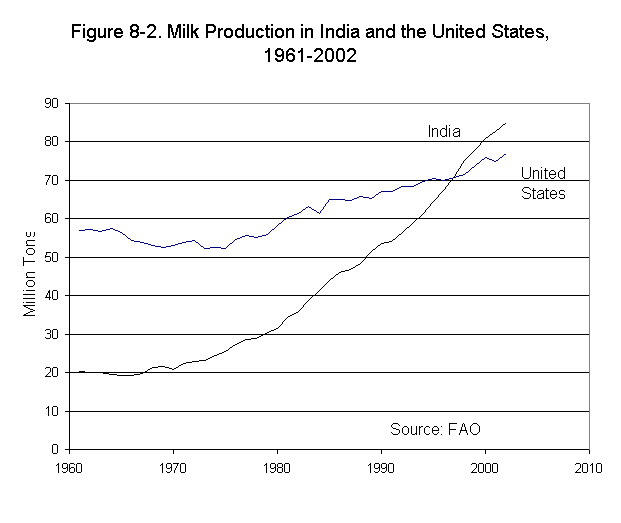Did you know? A bicycle is a marvel of engineering efficiency, one where an investment in 22 pounds of metal and rubber boosts the efficiency of an individual mobility by a factor of three. On my bike I estimate that I get easily 7 miles per potato. For more information view the text and data in Chapter 6 of Plan B 4.0: Mobilizing to Save Civilization.
Chapter 8. Raising Land Productivity: A Second Harvest
Another initiative that can have the effect of raising land productivity involves ruminants, such as cattle, sheep, and goats. Although rangelands are being grazed to capacity and beyond, there is a large unrealized potential for feeding agricultural residues—rice straw, wheat straw, and corn stalks—to ruminants, which have a complex digestive system that enables them to convert roughage, which humans cannot digest, into animal protein. This means that a given grain crop can yield a second harvest—the meat or the milk that is produced with straw and corn stalks.
India has been uniquely successful in using cattle and water buffalo to convert crop residues into milk, expanding production from 20 million tons in 1961 to 85 million tons in 2002—a more than fourfold increase. Following a path of steady growth, milk became India's most valuable farm product in 1994, eclipsing rice. In 1997, India overtook the United States to become the world's leading milk producer. (See Figure 8-2.) Remarkably, it did so almost entirely by using farm byproducts and crop residues, avoiding the diversion of grain from human consumption to cattle.28
Between 1961 and 2002, India's milk production per person increased from 0.9 liters per week to 1.6 liters, or roughly a cup of milk per day. Although this is not a great deal by western standards, it is a welcome expansion in a protein-hungry country.29
India's milk is produced almost entirely by small farmers with one to three cows. Milk production is integrated with crop production, involving an estimated 70 million farmers for whom it is a highly valued source of supplemental income. Ownership of a few cows also means a supply of manure for fertilizer.30
In China, where double cropping of winter wheat and corn is common, wheat straw and corn stalks are removed from the land because there is not enough time for them to decompose before the next crop is planted. As the world's leading producer of both rice and wheat and the second largest producer of corn, China annually harvests an estimated 500 million tons of straw, corn stalks, and other crop residues. At present, with much of this either burned, simply to dispose of it, or used as fuel for cooking, there is a large potential for China to follow India's lead in using crop residues to raise protein productivity.31
The ammoniation of crop residues (the incorporation of nitrogen) in the roughage helps microbial flora in the rumen of the cattle and sheep to digest the roughage more completely. The use of this technology in the major crop-producing provinces of east central China—Hebei, Shandong, Henan, and Anhui—has already created a "Beef Belt." Beef output in these four provinces now dwarfs that of the grazing provinces of Inner Mongolia, Qinghai, and Xinjiang.32
The achievements of China in aquaculture, of India in expanding its milk production, and of other countries in producing protein more efficiently hold out hope for being able to satisfy the growing world demand for protein without clearing additional land for agriculture, assuming that we can stabilize population soon.
ENDNOTES:
28. Roughage conversion from A. Banerjee, "Dairying Systems in India," World Animal Review, vol. 79/2 (Rome: FAO, 1994), and from S. C. Dhall and Meena Dhall, "Dairy Industry--India's Strength in Its Livestock," Business Line, Internet Edition of Financial Daily from The Hindu group of publications, at www.indiaserver.com/businessline/1997/11/07/stories/03070311.htm, 7 November 1997; Figure 8-2 from FAO, FAOSTAT, op. cit. note 2, livestock data updated 9 January 2003.
29. Calculation based on FAO, FAOSTAT, op. cit. note 2, livestock data updated 9 January 2003.
30. Banerjee, op. cit. note 28.
31. China's crop residue production and use from Gao Tengyun, "Treatment and Utilization of Crop Straw and Strover in China," Livestock Research for Rural Development, February 2000.
32. Ibid.; China's Beef Belt from USDA, ERS, "China's Beef Economy: Production, Marketing Consumption, and Foreign Trade," International Agriculture and Trade Reports: China (Washington, DC: July 1998), p. 28.
Copyright © 2003 Earth Policy Institute


